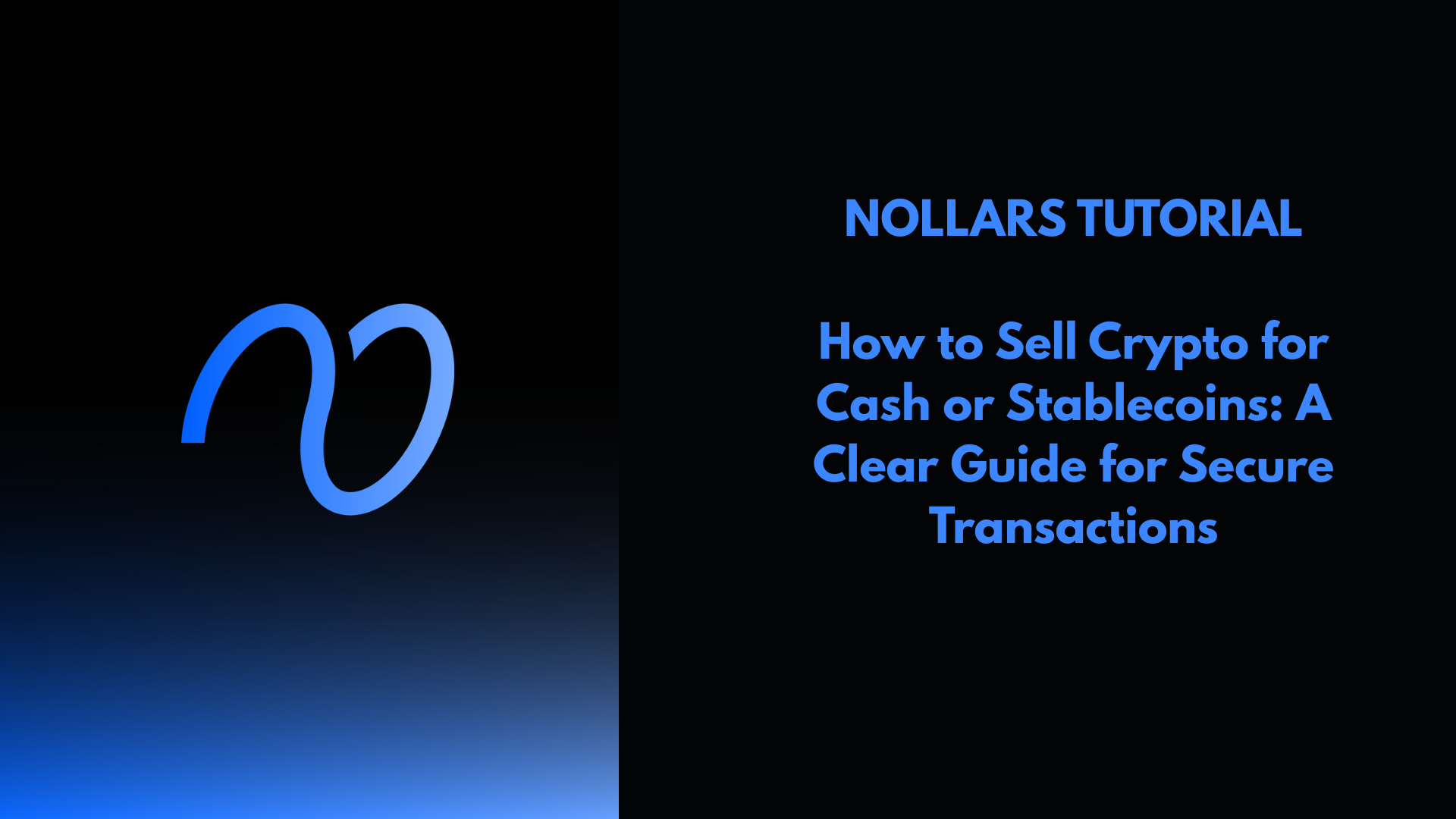Selling cryptocurrency isn’t as complicated as it might seem, once you actually know your options. You can swap your crypto for stablecoins or straight-up cash, depending on what you’re after.
Honestly, the easiest way is to use a trusted exchange that lets you convert your coins into cash or stablecoins fast, often with pretty reasonable fees.

Stablecoins make it simple to keep your value in the crypto world, without all the wild price swings. But if you want actual cash, you can convert crypto directly to your bank account or use a cash-out service.
It really comes down to knowing the differences—so you can pick the method that fits your needs best.
This guide lays out how to sell crypto safely and efficiently, whether you’re eyeing stablecoins or want real money in your hands.
We’ll cover what to watch for with fees, platforms, and timing—since those can mess with your final payout.
Key Methods to Sell Crypto for Cash or Stablecoins
When you’re selling crypto, you’ve got a few main options, each with its own quirks. Centralized platforms, direct trades with other people, and decentralized systems all offer something a little different.
Some folks care about convenience, others about privacy. You’ll probably find yourself leaning one way or another.
Centralized Exchanges
Centralized exchanges (CEX) like Coinbase, Binance, and Kraken are super popular for selling crypto quickly. You create an account, finish identity verification, and deposit your crypto to sell it for cash or stablecoins like USDT or USDC.
These platforms usually let you cash out with bank transfers—SEPA, wire, you name it. Fees and processing times depend on the exchange and payment method, but at least they’re usually upfront about it.
Security is a big deal here. Honestly, keeping large amounts on an exchange isn’t ideal, so most people move their funds to a personal wallet after selling.
Centralized exchanges also report transactions to tax authorities, so that’s something to keep in mind.
Peer-to-Peer Marketplaces
Peer-to-peer (P2P) marketplaces let you sell crypto directly to buyers. Sites like LocalBitcoins and Paxful list buyers who want to pay cash or stablecoins.
You pick offers based on price, payment method, and buyer reputation—not a bad way to get a deal if you’re careful.
P2P trades support all sorts of payment types: bank transfers, cash deposits, even mobile payment apps. Escrow services hold your funds until payment is confirmed, which helps protect against scams.
This method usually comes with lower fees than centralized exchanges and offers a bit more privacy.
Still, you have to vet buyers carefully and stay alert for fraud. P2P works best if you want more control or need local payment options.
Decentralized Exchanges and DEX Aggregators
Decentralized exchanges (DEXs) let you swap crypto straight from your wallet, no middleman needed. Uniswap and Sushiswap, for example, support stablecoin trading pairs—so you can move between cryptos and stablecoins like USDC or DAI pretty quickly.
DEX aggregators scan multiple DEXs to find the best rates and lowest fees automatically. It’s all blockchain-based, so you’ll need to know your way around wallets and protocols.
You keep full control of your funds, which is a big plus for security. But you can’t sell directly for fiat cash on DEXs.
If you need cash, you’ll have to move your stablecoins to a centralized exchange or use another withdrawal method.
DEXs tend to have lower fees and don’t require you to set up an account, making them a favorite for frequent traders looking to convert to stablecoins fast.
If you want more details on cashing out stablecoins, check out this guide to cashing out stablecoins.
Step-by-Step Process for Selling Crypto
Selling crypto means moving your funds to the right platform, deciding what you want in return, and wrapping up the sale while making sure you withdraw your money securely.
Each step needs a bit of care—skip one, and you might hit a snag.
Transferring Crypto to the Platform
First up, you need to move your cryptocurrency from your wallet (or another exchange) to the platform where you want to sell.
Find the deposit address on the platform. Double-check it—seriously, one wrong character and your coins could vanish.
Always make sure you’re using the right network (Ethereum, Bitcoin, whatever the platform supports). Sending on a wrong network can mean your funds are gone for good.
Transaction fees and times can vary a lot. Bitcoin transfers, for example, often take longer and cost more.
Watch your transaction status until it confirms on the blockchain—don’t just assume it went through.
Choosing Between Cash and Stablecoin Options
Once your crypto lands on the platform, you’ll have to pick: do you want to convert it into cash (your local currency) or into stablecoins like USDT or USDC?
Cash withdrawals are straightforward but sometimes come with longer processing times and higher fees, depending on where you live and what platform you use.
Stablecoins move fast and don’t swing in value, so they’re handy if you want to hold funds or trade later.
Most platforms show you current exchange rates and fees for both choices. It’s worth comparing before you hit “sell.”
Completing the Sale and Withdrawing Proceeds
When you’re ready, select the crypto amount you want to sell and confirm.
The platform will convert your crypto into whatever you chose—cash or stablecoin.
After that, you can withdraw your funds. For cash, you’ll usually need to link a bank account or payment system.
Withdrawals can take anywhere from a few minutes to several days, depending on the method and your country’s rules.
Check withdrawal limits and any identity verification steps before you start. It’s a headache if you get stuck halfway through.
Keeping records of all your transactions helps with tracking and, well, taxes.
If you want step-by-step help, Coinbase Help is a solid resource.
Security, Fees, and Best Practices
Selling crypto comes with its share of costs and risks. Fees can eat into your payout, and security mistakes can cost you big time.
If you can dodge the usual pitfalls, you’re already ahead of the game.
Understanding Transaction Fees
Transaction fees are what you pay to transfer crypto or stablecoins between wallets or exchanges. Fees change based on network traffic and which coin you’re moving.
Ethereum fees, for example, can spike during busy periods, sometimes even more than Bitcoin.
You’ll usually see two types of fees:
- Network fees: These go to miners or validators to process your transaction.
- Exchange fees: The platform charges these for converting or withdrawing funds.
Stablecoin transfers usually cost less than moving volatile cryptocurrencies, but don’t assume they’re free.
Always check the fee schedule before selling, and make sure you’ve got enough to cover costs—otherwise, your transaction might fail or get delayed.
Want more info? Check out stablecoin transaction fees at Mural Pay.
Ensuring Privacy and Security
Start by picking a reputable exchange. Look for two-factor authentication, cold storage, and encrypted user data—those features matter.
Don’t use public Wi-Fi for transactions. Use strong, unique passwords, and keep your software and wallets updated.
If you want more privacy, decentralized exchanges or P2P trading expose less of your personal data. But you’ll need to be extra careful to avoid scams.
Check your accounts regularly for anything weird. Staying on top of things helps you catch issues before they get ugly.
Avoiding Common Mistakes
One of the easiest ways to lose crypto? Sending it to the wrong wallet address. Always double-check before hitting “send.”
Don’t overlook fees—they can add up and even cause your transaction to fail if you underpay.
Selling on sketchy platforms or rushing the process can open you up to scams. Stick to well-known exchanges and check their reputation.
If you’re selling a big chunk of crypto, splitting it into smaller sales can help you avoid compliance headaches or high fees. It’s just safer that way.
Frequently Asked Questions
Selling crypto isn’t rocket science, but you do need to know the steps, costs, and timing. Picking the right platform makes a surprisingly big difference in how quickly you get your cash or stablecoins.
What are the steps to sell cryptocurrencies for cash?
Start by picking a crypto exchange or platform that lets you withdraw cash. Sell your crypto for fiat currency or stablecoins.
Then, link your bank account or payment method and request the withdrawal. Some platforms require identity checks before you can finish up.
What is the most cost-effective method to convert cryptocurrencies to cash?
Look for exchanges with low fees and decent rates. Sometimes, converting to stablecoins first can help you save on withdrawal costs.
Peer-to-peer platforms might offer better rates, but they come with more risk. Always compare before you sell.
Is it possible to withdraw Bitcoin directly to a bank account?
You can’t send Bitcoin straight to a bank account. You’ll need to convert it to fiat currency through an exchange or broker first.
After that, you can transfer the fiat to your bank using whatever deposit methods the platform supports.
What are the fastest ways to convert cryptocurrencies into cash?
Crypto exchanges with instant fiat withdrawal options are probably your quickest bet. Peer-to-peer platforms with local buyers can also speed things up.
Some ATMs let you withdraw crypto as cash, but be ready for higher fees.
Where can I find services to sell Bitcoin for cash in person?
Bitcoin ATMs are a solid physical option for quick cash sales. Use ATM locator sites to find one nearby.
Local crypto meetups or peer-to-peer services can work too, but definitely take safety precautions if you go that route.
How do I convert stablecoins to cash seamlessly?
You can sell stablecoins on most crypto exchanges for fiat currency. Since these coins are pegged to things like the US dollar, you usually won’t see wild price swings.
Pick an exchange you actually trust, and double-check their withdrawal fees and how long payouts take. If you want to dig deeper, check out more info at factors to consider when selling your USDC.




